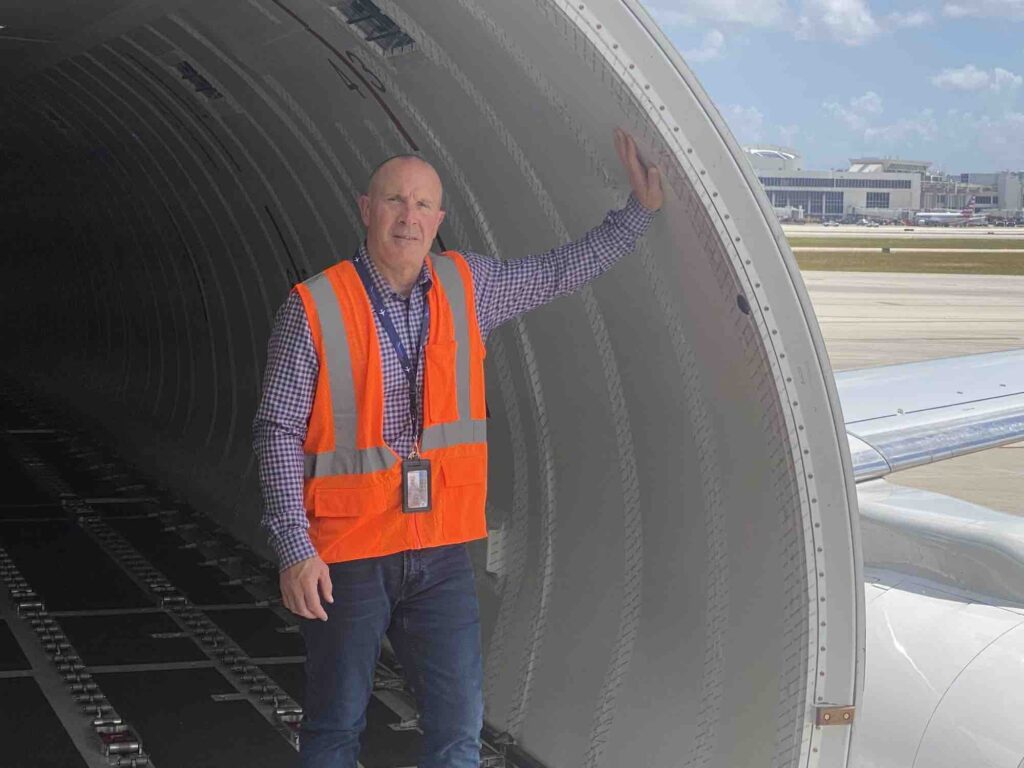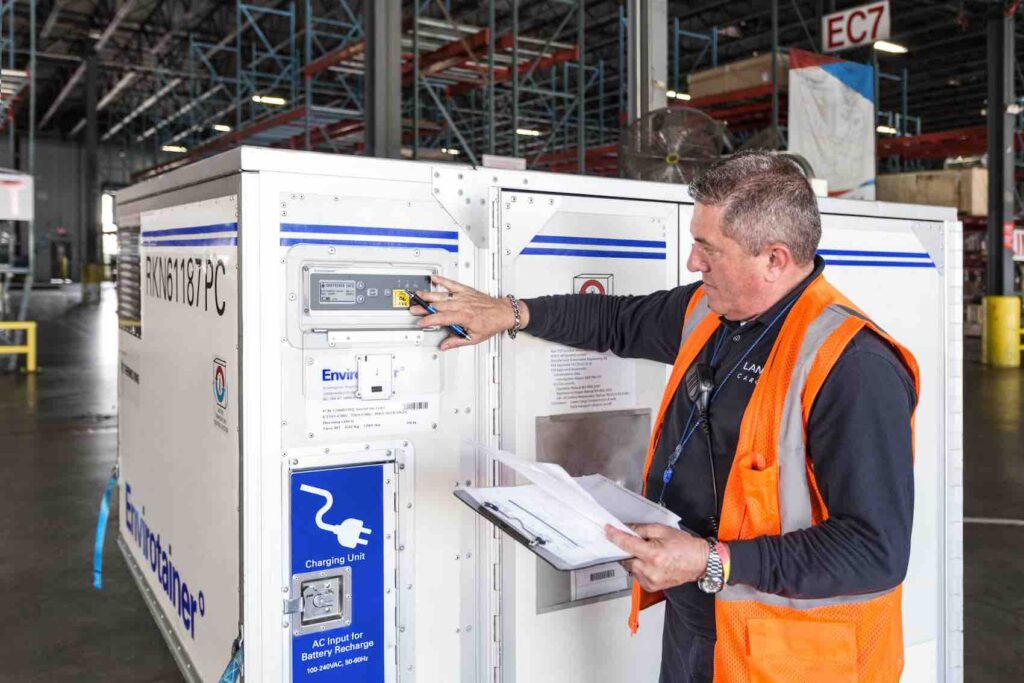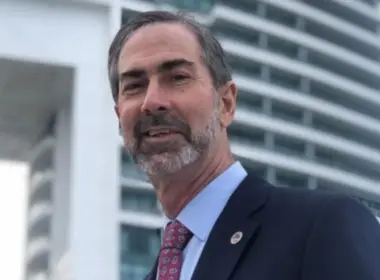How pharmaceuticals helped save Miami International Airport
By Doreen Hemlock
As VP of Global Operations at Amerijet International, Chris Mazzeo oversees the company’s activities at Miami International Airport (MIA). The all-cargo airline, based in Miami, flies some 20 aircraft, and employs more than 1,000 people worldwide. What gives Amerijet an edge in shipping by air is their extensive refrigerated warehouse space at MIA, which means they can ship pharmaceutical products.

When COVID-19 hit in early 2020 and passenger flights halted, revenues took a dive at MIA. What kept the airport from a financial crash were cargo services, with an extra lift from pharmaceutical shipments.
Here’s how. MIA has long ranked as the No. 1 airport in the United States for international freight, thanks largely to its imports of fresh flowers, fish, and fruit from Latin America and the Caribbean. To handle so many perishable products, companies that use the airport developed a massive network of refrigerated trucks, warehouses, and temperature-controlled facilities called a “cold-chain.”
About a decade ago, MIA leaders decided to mobilize that cold-chain to handle more pharmaceuticals, which often need to stay refrigerated. MIA encouraged airlines, freight forwarders, and other airport users to earn a new certification for handling pharmaceutical products. Six companies completed the rigorous process, and in 2015, MIA became the first airport in the United States to be named a “pharma hub” by the International Air Transport Association (IATA). At the time, only one other airport had that designation: Brussels, Belgium.
Becoming an IATA pharma hub gave increased confidence to manufacturers and buyers that medicines passing through the airport would be properly processed. MIA’s pharma business grew and stayed strong during early COVID. It then took off with the advent of COVID vaccines. “We had a record year in cargo in 2021, and pharma was obviously a big contributor,” says Emir Pineda, who handles passenger, trade, and logistics development for the Miami-Dade Aviation Department. Among the many medicines processed: COVID vaccines heading to Latin America and the Caribbean.
In all, MIA handled nearly 20,000 metric tons of pharmaceuticals in 2021, up more than 20 percent from 2019’s pre-COVID volume and setting a new record. Most of the medicines, like the vaccines, were exported. The total value of MIA’s pharma cargo in 2021: $6.6 billion, according to Aviation Department data.
“We’re seeing an increase in pharma in 2022 too, after some delays in 2021,” adds Pineda. “We’re also promoting certified pharma lanes to manufacturers (like Brussels-Miami) to attract business, because companies can’t afford billons in losses on vaccines that were mishandled because of temperature.”
The tough process to become a “pharma hub”
Getting and keeping MIA’s designation as an IATA pharma hub isn’t easy. The process requires that individual companies handling medicines spell out their processes step by step, train employees, and undergo inspections to complete IATA’s Center of Excellence for Independent Validators (CEIV) pharma certification program. Each certified company must also be re-validated, usually every two years.
A little over a year ago, Amerijet tapped Chris Mazzeo to be its VP in charge of global operations, partly because of his experience with shipping pharmaceuticals; Mazzeo had previously served as an IATA consultant. Amerijet offers scheduled and charter services to a variety of locations in Europe, Latin America and the Caribbean, but key to its pharma business are flights to Brussels, IATA’s first pharma hub, and to the U.S. Commonwealth of Puerto Rico, a major pharma manufacturer.


Mazzeo says it took about a year for Amerijet to earn its initial CEIV Pharma certification. That involved spelling out its organizational structure, training courses, audit system, complaint resolution, and more. It required refining its quality management program. It even meant mapping temperatures in warehouses, specifying where air-conditioning vents and doors were located, and checking that “cool rooms” stayed in the required temperature range.
“You have to have everything documented from A to Z, and you must have risk assessments in case of any deviation,” Mazzeo says. “It’s very detailed, with strict guidelines. What’s important is everyone understands everyone’s responsibilities, so if there’s a problem, you can identify who is responsible.”
Re-validation takes new refinements, too. “The process continually evolves to improve the quality of handling for pharma. We’re constantly looking at how we operate and evaluate,” says Mazzeo.
Indeed, the process is so detailed that Amerijet set up a new department just for CEIV pharma certification. Its manager works with customers to develop Service Level Agreements in their pharma contracts.
With its IATA certification in place, Mazzeo estimates pharma now accounts for 15 to 20 percent of Amerijet’s business on regularly scheduled flights. “Without that certification, many freight forwarders won’t even consider using you,” says Mazzeo. “And it’s fantastic, because the standard is global.”
Why IATA launched the “pharma hub” program
IATA adopted the pharma certification program a decade ago for two main reasons: to encourage more air transport of pharma products and to help drug manufacturers reduce spoilage in transport. The aviation group recognized a loss of market share in pharma products, as manufacturers turned more to land and sea shipments that tend to be cheaper than air. Just 11 percent of pharma products were flown in 2013, down from 17 percent in 2000, IATA found. At the same time, pharma companies faced mounting losses from mishandling, with spoilage responsible for as much as $10 billion some years, IATA estimated.
Today, the list of IATA certified pharma organizations has swelled. Airports designated as pharma hubs include Dallas in North America; Montevideo in South America; and Singapore, Hong Kong, Tokyo, and Mumbai in Asia. MIA increasingly partners with Mumbai because generic drugs made in India are flown through Miami and onward to Latin America. Besides Amerijet, companies with pharma certification at MIA include American Airlines Cargo, DHL Global Forwarding, LATAM Airlines, Swissport Cargo Services, and logistics provider Kuehne & Nagel.
Of course, pharma was not the only freight that lifted MIA’s fortunes since the pandemic began. Like other airports with large volumes of cargo, MIA benefitted from a shift in fundamentals.
Airports typically handle lighter, higher-value and time-sensitive goods because air transport is faster but costs more. Seaports instead tend to handle heavier, lower-value items, from furniture to sweatpants, because shipping takes longer but costs less. COVID shifted those economics, however. With fewer passengers flying, airlines dedicated more space to cargo, pushing down costs for air transport. Meanwhile, disruptions at seaports led to spikes in prices for ocean-borne cargo, narrowing the price difference between air and sea shipping.
“What saved MIA was cargo and logistics, and a lot of that was stuff you order on Amazon and other e-commerce sites,” items from protective masks to home electronics, says MIA’s Pineda.
The shift helped MIA set a record for air cargo in 2021 in all product categories: 2.7 million tons handled, including 2.2 million of international freight. The total value of those goods: $67.5 billion, up 28 percent from 2020 levels. Pharma jumped to comprise 10 percent of the value of all MIA freight, data shows.
MIA’s air-freight community wants to keep those pharma volumes growing. Some leaders see opportunity in greater automation. Today, numerous countries still require crews to land and physically submit paper documents before processing their incoming freight. Sending forms electronically before landing would speed release of cargo and encourage use of air transport, participants said at a recent Air Cargo Americas conference in Miami.
MIA is also boosting promotions of its “pharma hub” to secure more business, with officials speaking at conferences and hosting such groups as BioFlorida at refrigerated warehouses. “As we get better and better at moving pharmaceuticals by air and maintaining the cold-chain,” says Pineda, “we’ll see more and more business shifting from ocean transport. Air cargo is faster and more efficient.”












